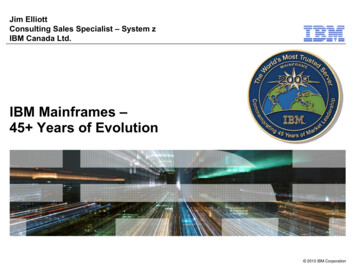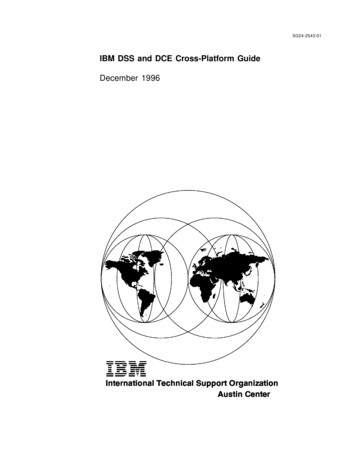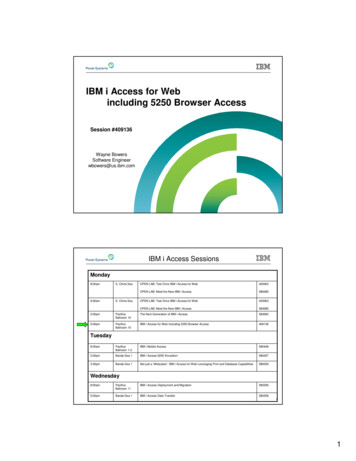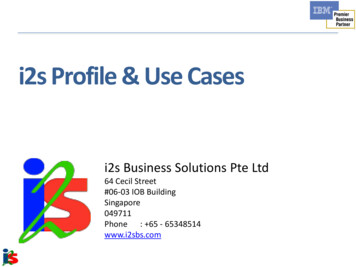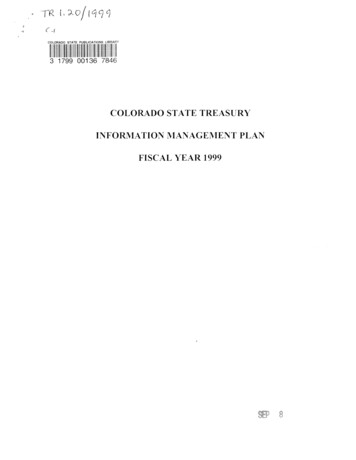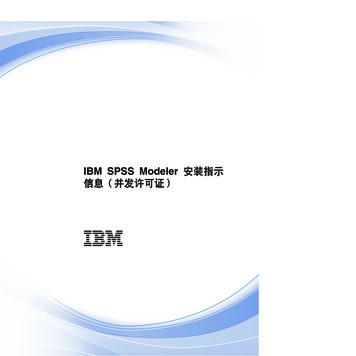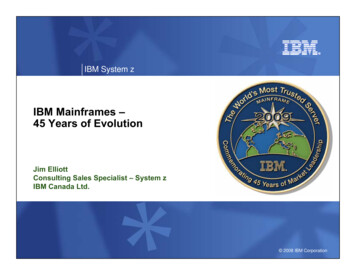
Transcription
IBM System zIBM Mainframes –45 Years of EvolutionJim ElliottConsulting Sales Specialist – System zIBM Canada Ltd. 2008 IBM Corporation
IBM System zReports of the death of themainframe were premature “I predict that the last mainframe willbe unplugged on March 15, 1996.”– Stewart Alsop, March 1991 “It’s clear that corporate customersstill like to have centrally controlled,very predictable, reliable computingsystems – exactly the kind ofsystems that IBM specializes in.”– Stewart Alsop, February 2002Source: IBM Annual Report 20012The 45 Year Evolution of IBM Mainframes2009-03-20
IBM System zIn the BeginningThe First Two Generations 2008 IBM Corporation
IBM System zThe family tree – 1952 to 1964 Several mainframe familiesannounced, designed fordifferent applications Every family had a different,incompatible architecture Within families, moving fromone generation to the next wasa migration– Common compilers mademigration easier – COBOL andFORTRAN4The 45 Year Evolution of IBM Mainframes2009-03-20
IBM System zIBM 701 – 19521st generation The first IBM large-scale electronic computer manufactured inquantity IBM's first commercially available scientific computer The first IBM machine in which programs were stored in aninternal, addressable, electronic memory The first of the pioneering lineof IBM 700 series computers,including the 702 through 7097015The 45 Year Evolution of IBM Mainframes2009-03-20
IBM System zIBM 305 RAMAC – 19561st generation The first computer to include a disk drive (named the IBM 350 DiskFile) Prior to this magnetic computer storage had consisted of corememory, tape, and drums The 350 Disk File consisted of a stack of fifty 24” discs The capacity of the entire disk file was 5 million 7-bit characters,which works out to about 4.4 MB in modern parlance350 Disk6The 45 Year Evolution of IBM Mainframes2009-03-20
IBM System zIBM 1401 – 19592nd generation The all-transistorized IBM 1401 Data Processing System placed thefeatures found in electronic data processing systems at thedisposal of smaller businesses,729140214011403previously limited to the use ofconventional punched cardequipment These features included: highspeed card punching andreading, magnetic tape inputand output, high speedprinting, stored program, andarithmetic and logical ability7The 45 Year Evolution of IBM Mainframes2009-03-20
IBM System zIBM 1440 – 19622nd generation Low-cost system specifically designed to solve the increasing datahandling problems of smaller volume businesses The 1440 met the need for a complete accounting system andoffered the benefits of a144314411311business information system With a variety of models andspecial features available forthe 1440, a system could betailored to meet immediatedata processing requirementsand expanded to absorbincreased demands8The 45 Year Evolution of IBM Mainframes2009-03-20
IBM System zIBM 7094 – 19622nd generation Built for large-scale scientific computing Compatible with the IBM 7090, the advanced solid-state IBM 7094offered substantial increases in internal operating speeds andfunctional capacities New expanded functions provided with the IBM 70947094were: double-precisionfloating-point operationsand seven index registers9The 45 Year Evolution of IBM Mainframes2009-03-20
IBM System zThe April 1964 Revolution3rd generation 2008 IBM Corporation
IBM System zDuring the 1950s, Data Processing came of age Data Processing machines existed – sorters, collators, tabulators "Computers" were devoted almost entirely to the processing ofcomputationally intensive tasks Demand for computers, as data processing machines, boomed andnew machines were built to meet this demand Customers were getting very frustrated with migration costs thatcame with processor upgrades11The 45 Year Evolution of IBM Mainframes2009-03-20
IBM System z12The 45 Year Evolution of IBM Mainframes2009-03-20
IBM System zSystem/360 – Announced April 7, 1964 IBM decided to implement a wholly new architecture specificallydesigned both for data processing and to be compatible across awide range of performance levels IBM invested 5B to develop a family of five increasingly powerfulcomputers that run the same operating systems and can usethe same 44 peripheral deviceswith the same architectureS/360-75– Architecture published in the S/360Principles of Operation– 24-bit addressing (32-bit architecture)– Solid logic circuit cards240113The 45 Year Evolution of IBM Mainframes2009-03-202311
IBM System zSystem/360 – a child is born Hardware– One main storage, maximum size is 16MB– One or two Central Processing Units (CPUs)– One to seven Channels– Selector or Byte Multiplexor– Block Multiplexor– Control Units (which connect to Channels)– Devices (which connect to Control Units) Family of operating systems– Operating System/360 (OS/360)– Disk Operating System/360 (DOS/360)– Tape Operating System (TOS)– Basic Programming Support (BPS)– Airlines Control Program (ACP)14The 45 Year Evolution of IBM Mainframes2009-03-20
IBM System zCoreMemory15The 45 Year Evolution of IBM Mainframes2009-03-20
IBM System zS/360 family16ModelAnnouncedFirst Shipped30April 7, 1964June, 196540April 7, 1964April, 196550April 7, 1964August, 196520*November 18, 1964April, 196665April 22, 1965November, 196575April 22, 1965January, 196644August 16, 1965June, 196667August 16, 1965May, 196691January 18, 1966October, 196725January 3, 1968October, 196885January 30, 1968December, 1969195August 20, 1969March, 1971The 45 Year Evolution of IBM Mainframes2009-03-20Virtual storageHigh speed cache
IBM System zSystem/360 Model 2019662560 Multi-Function Card Machine Special purpose“entry level” S/360 24K of core memory Half the registers ofother models Instruction set thatwas not binarycompatible with therest of the S/360family Popular as an RJEworkstation17The 45 Year Evolution of IBM Mainframes2009-03-20
IBM System zSystem/360 Model 67 First IBM system with virtual storage capabilities– S/360 Model 65 with addition of the Dynamic Address TranslationfacilityS/360-67 Operating systems– Time Sharing System –The “official” operating systemfrom IBM Data Systems Division– Control Program/67 with theCambridge Monitor System –The “unofficial” operating systemfrom the IBM Cambridge ScientificCenter“DAT box”University of Newcastle Upon Tyne18The 45 Year Evolution of IBM Mainframes2009-03-20
IBM System zSystem/370 – Announced June 30, 1970 Compatible upgrade from S/360 370 Model 145 is the first computer with fully integrated monolithicmemory (circuits in which all of the same elements – resistors,capacitors and diodes – are fabricated on a single slice of silicon)and 128-bit bi-polar chips New peripherals– 3330/3340/3350 disk"We are confident that the performance– 3211 printerof System/370, its compatibility, itsengineering and its programming willmake it stand out as the landmark forthe 1970s that System/360 was for theSixties."Tom Watson, Jr.IBM Chairman and CEO1961-197119The 45 Year Evolution of IBM Mainframes2009-03-20
IBM System zSystem/370 with Virtual Storage –Announced August 2, 1972 Compatible upgrade from S/370 with virtual storage First multiprocessor models (158MP, 168MP) Family of operating systems– OS/360 Î OS/VS3850 Mass Storage Subsystem– DOS/360 Î DOS/VS3705S/370-148– CP/67 Î VM/370350520The 45 Year Evolution of IBM Mainframes2009-03-203203352533503270
IBM System zS/370 – the architecture matures Virtual storage– 2KB or 4KB pages of memory– 64KB or 1MB segment sizes– Translation of virtual addressesto real addresses using DynamicAddress Translation (DAT) logic– Segment tables point to pagelocations Channel architecture– 256 channels CPU changes– Extended MP support via CPUaddress21The 45 Year Evolution of IBM Mainframes303330312009-03-20
IBM System zS/370 irst ShippedReplacement155June 30, 1970January, 1971158165June 30, 1970April, 1971168195June 30, 1970August, 1973145September 23, 1970June, 1971148135March 8, 1971April, 1972138158August 2, 1972April, 19733031168August 2, 1972May, 19733033125October 4, 1972April, 19734331/4361115March 13, 1973March, 19744331/4361138June 30, 1976November, 19764341/4381148June 30, 1976January, 19774341/4381The 45 Year Evolution of IBM Mainframes2009-03-20
IBM System zSystem/370 with Extended Architecture Evolution of S/370 3081 introduced ThermalConduction Modules New peripherals– 3800 page printer– 3370/3380 disk– 3480 tape Family of operating systems– OS/VS Î MVS/SP Î MVS/XA– DOS/VS Î VSE/SP– VM/370 Î VM/SP, VM/SP HPO– VM/370 Î VM/XA MA Î VM/XA SF Î VM/XA SP23The 45 Year Evolution of IBM Mainframes2009-03-203083
IBM System z370-XA – radical surgery for the architecture Extended storage addressing– 24-bit or 31-bit addressing– 4KB pages in 1MB segments Interpretive execution facility– Start Interpretive Execution (SIE) instruction– SIE runs until interception condition raised– Used by VM/XA– Multiple High Performance Guest Support Facility (MHPGSF) tosupport V F guests on VM/XA SP Rename Processor Resource/Systems Manager (PR/SM) when LogicalPartitions (LPAR) announced 370-XA channel design– CHPIDs– Subchannels24The 45 Year Evolution of IBM Mainframes2009-03-20
IBM System zSystem/370 with Enterprise Systems Architecture Extension of 370-XA– Expanded Storage– Multiple 31-bit address spaces Common set of peripheral devices– 3390 disk– 3490 tape Family of operating systems– MVS/XA Î MVS/ESA– VSE/SP Î VSE/ESA– VM/XA SP Î VM/ESA25The 45 Year Evolution of IBM Mainframes30902009-03-20
IBM System zSystem/390 with Enterprise Systems Architecture –Announced September 19909672-G5 Evolution of ESA/370 1994 – S/390 Parallel Transaction Server– Family of CMOS processors 1998 – System/390 Generation 5 server – more than 1,000 MIPS 1999 – System/390 Generation 6 server – copper chip technology Common set of peripheral devices– RAMAC, Enterprise Storage Subsystem disk– 3590 Magstar tape Family of operating systems– MVS/ESA Î OS/390ES/9000– VSE/ESA– VM/ESA– Linux for S/390 (December 1999)26The 45 Year Evolution of IBM Mainframes2009-03-20
IBM System zS/370 to ES/9000 evolution27115/125138/148158/168 4331 Î 432143413031/3032/3033 436143813081/3083/3084 upgrade 93704381-E3090 upgrade upgrade922191219021The 45 Year Evolution of IBM Mainframes2009-03-20
IBM System zParallel Transaction Server to G61994-04-069672-Enn,9672-PnnParallel Transaction Server1994-09-139672-Rn1Parallel Enterprise 4G31996-09-102003Multiprise 9-207060Multiprise 30001999-05-039672-nn7G6Multiprise 300028The 45 Year Evolution of IBM Mainframes2009-03-20
IBM System zzSeries with z/Architecture – Announced October 2000 Evolution of ESA-390– 24-bit, 31-bit, and 64-bit addressingsupported concurrently– z900 – up to 16 processors– z800 – up to 4 processorszSeries 900 Linux-only model in January 2002 General purpose model in February 2002– Integrated Facility for Linux on z900/z890 Family of operating systems– OS/390 Î z/OS– VSE/ESA Î z/VSE– VM/ESA Î z/VM– TPF Î z/TPF– Linux for S/390 Î Linux for zSeries29The 45 Year Evolution of IBM Mainframes2009-03-20
IBM System zzSeries Enhanced May 2003– z990 – up to 32 processors – configurable as CPs, IFLs, SAPs– Up to 256GB memory October 2003zSeries 990– The Mainframe Charter April 2004– z890 – up to 4 configurable processors– zSeries Application Assist Processor October 2004– Crypto Express 2 January 2005– FICON Express 230The 45 Year Evolution of IBM Mainframes2009-03-20
IBM System zSystem z9 EC – Announced July 26, 2005 Strengthening the role of the mainframe as the data hub of theenterprise New versatile capacity settings designed to optimize capacity andcost IBM System z9 Integrated Information Processor (IBM zIIP) isdesigned to improve resource optimization and lower the cost ofeligible work Continued improvement in IBM FICON performanceand throughput On demand innovative technologies to help meetever-changing business demands31The 45 Year Evolution of IBM Mainframes2009-03-20
IBM System zSystem z9 BC – Announced April 27, 2006 IBM System z9 technology, for entry level to midsize capacityneeds, with a wide choice of capacity settings and highly granulargrowth options, an increase of 2.6 times more capacity settingsthan zSeries z890 A broad set of specialty engines to facilitate integration of manytypes of workloads and fully leverage the power of the mainframe Helps protect client’s investments in mainframe technologies withupgradeability from z890 and z800 servers Key System z9 features of advanced security, resiliency,virtualization and connectivity technologies delivered in amidrange package32The 45 Year Evolution of IBM Mainframes2009-03-20
IBM System zSystem z10 EC – Announced February 26, 2008 Unprecedented capacity and virtualization to meet consolidationneeds Improvements connecting to data and the network can helpprovide faster access to data Just-In-Time deployment of resources Specialty engines offer an attractive alternative when running newworkloads Enhanced accuracy to a time External Time Source33The 45 Year Evolution of IBM Mainframes2009-03-20
IBM System zSystem z10 BC – Announced October 21, 2008 Industry leading combination of System z10 security, resiliency,virtualization and connectivity technologies packaged specificallyas a midrange enterprise solution Specialty engines offer an attractive alternative when running newworkloads Save energy via consolidation of disparate workloads and reducecosts via virtualization capabilities for more efficient resourcesharing Enables future growth—as a modern platform for a growingportfolio of business solutions Up to 50% more performance at half the price for incremental Linuxworkloads compared to the System z9 BC34The 45 Year Evolution of IBM Mainframes2009-03-20
IBM System zIBM System z: Balanced Systems DesignBalanced SystemCPU, nWay, Memory,I/O BandwidthSystem I/O Bandwidth288 GB/sec*172.8 GB/sec*96 GB/secMemory1.5 TB**ITR for1-way24 GB/sec512 GB256 GB 64 GB300450 600 92016-wayz10 EC32-wayz9 EC54-wayz99064-way*Servers exploit a subset of its designed I/O capability** Up to 1 TB per LPAR35The 45 Year Evolution of IBM MainframesProcessors2009-03-20z890
IBM System z9672-G5 to eServer zSeries to System -032064-1nnz9002002-04-302064-2Cnz900 Turbo2009-01-292006-0FLz800 Linux only 72086z8902005-07-262094System z9 EC (originally System z9 109)2006-04-272096System z9 BC2008-02-262097System z10 EC2008-10-212098System z10 BC36The 45 Year Evolution of IBM Mainframes2009-03-20
IBM System zApril 7, 2009 – The 45thAnniversary! 2008 IBM Corporation
IBM System zApril 7, 2004 – The 40th Anniversary!38The 45 Year Evolution of IBM Mainframes2009-03-20
IBM System z39The 45 Year Evolution of IBM Mainframes2009-03-20
IBM System zSummary From System/360 in 1964 to today’s System z and zSeries, we haveseen an evolution that has preserved customer investments in aunique way From OS/360 to MVS to OS/390 to z/OS, we have seen an evolutionof the operating system that is core to most corporate ITenvironments From DOS/360 to VSE/ESA to z/VSE, we have seen this operatingsystem thrive meeting the needs in smaller environments From CP/67 as a research project and VM/370 as a migration tool,VM has evolved to today’s z/VM as the core of IBM’s zSeriesvirtualization technology And now with Linux on System z, we have a truly open operatingenvironment“Legacy systems are systems that work!”40The 45 Year Evolution of IBM Mainframes2009-03-20
IBM System zBibliography Melinda Varian, Princeton– “VM and the VM Community: Past, Present, and Future” presented at SHARE 89, 1997 Jeff Gribbin, EDS UK– “Development of 360/370 Architecture – A Plain Man’s View”, 1989 Chuck Boyer– “The 360 Revolution”, 2004 available bookoffer/download/360revolution 040704.pdf IBM Archives: Valuable resources on IBM's history– http://www.ibm.com/ibm/history/ IBM Systems Journal– “VM/370–a study of multiplicity and usefulness”L H Seawright and R A MacKinnon, Volume 18, Number 1, 1979– Evolution of a virtual machine subsystemE C Hendricks and T C Hartmann, Volume 18, Number 1, 1979– “ESA/390 interpretive-execution architecture, foundation for VM/ESA”D L Osisek, K M Jackson, and P H Gum, Volume 30, Number 1, 1991 IBM Journal of Research and Development– “The Origin of the VM/370 Time-Sharing System”R J Creasy, Volume 25, Number 5, 198141The 45 Year Evolution of IBM Mainframes2009-03-20
IBM System zNotices Copyright IBM Corporation 2000, 2009. All rights reserved.This document contains words and/or phrases that are trademarks or registered trademarks of the InternationalBusiness Machines Corporation in the United States and/or other countries. For information on IBM trademarks goto http://www.ibm.com/legal/copytrade.shtml.The following are trademarks or registered trademarks of other companies.– Java and all Java-related trademarks and logos are trademarks of Sun Microsystems, Inc., in the United States and othercountries.– UNIX is a registered trademark of The Open Group in the United States and other countries.– Microsoft, Windows and Windows NT are registered trademarks of Microsoft Corporation.– Red Hat, the Red Hat "Shadow Man" logo, and all Red Hat-based trademarks and logos are trademarks or registeredtrademarks of Red Hat, Inc., in the United States and other countries.– Linux is a trademark of Linus Torvalds in the United States, other countries, or both.All other products may be trademarks or registered trademarks of their respective companies.Notes:– This publication was produced in Canada. IBM may not offer the products, services or features discussed in thisdocument in other countries, and the information may be subject to change without notice. Consult your local IBMbusiness contact for information on the product or services available in your area.– All statements regarding IBM's future direction and intent are subject to change or withdrawal without notice, and representgoals and objectives only.– Information about non-IBM products is obtained from the manufacturers of those products or their publishedannouncements. IBM has not tested those products and cannot confirm the performance, compatibility, or any otherclaims related to non-IBM products. Questions on the capabilities of non-IBM products should be addressed to thesuppliers of those products.– Prices subject to change without notice. Contact your IBM representative or Business Partner for the most current pricingin your geography.42The 45 Year Evolution of IBM Mainframes2009-03-20
IBM System z 6 The 45 Year Evolution of IBM Mainframes 2009-03-20 The first computer to include a disk drive (named the IBM 350 Disk File) Prior to this magnetic computer storage had consisted of core memory, tape, and drums The 350 Disk File consisted of a stack of fifty 24" discs The capacity of the entire disk file was 5 million 7-bit characters,





